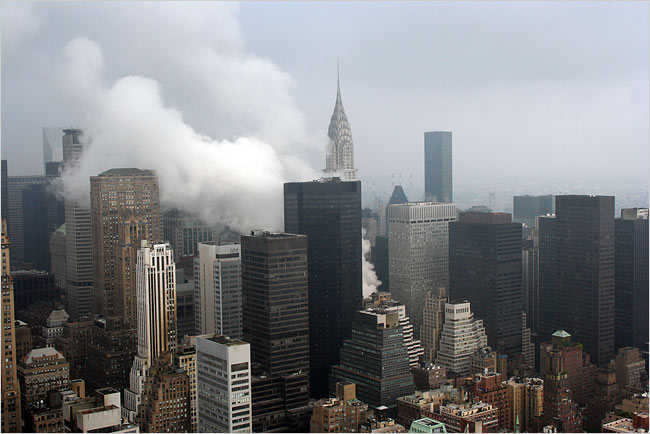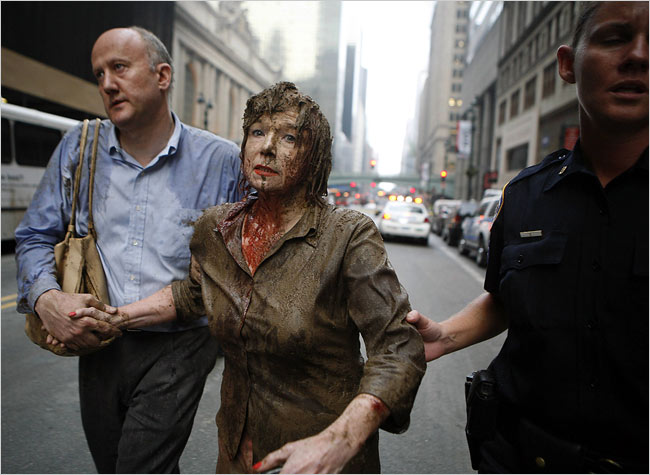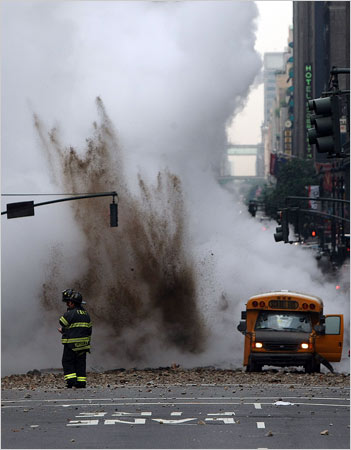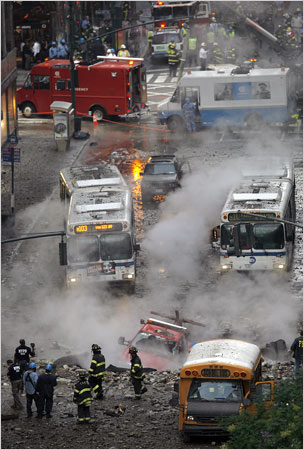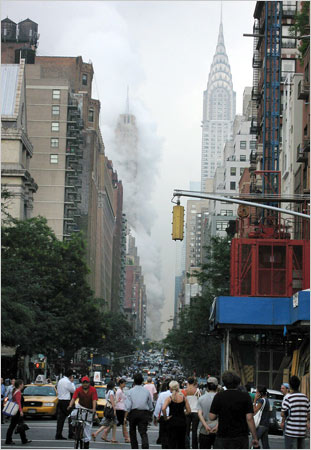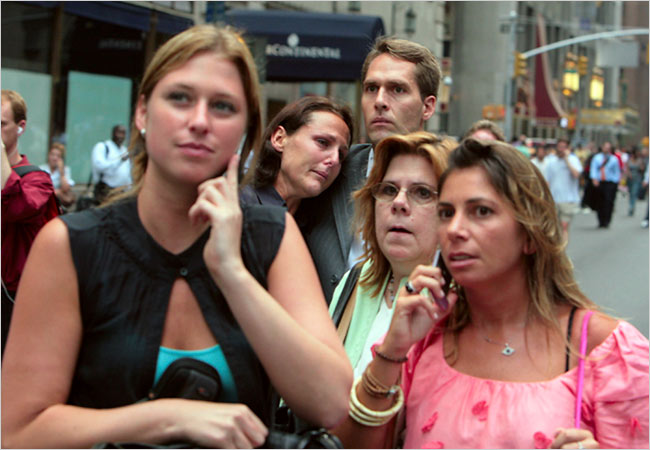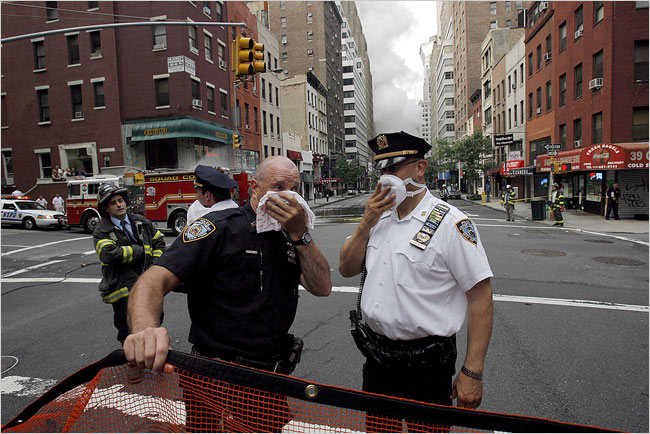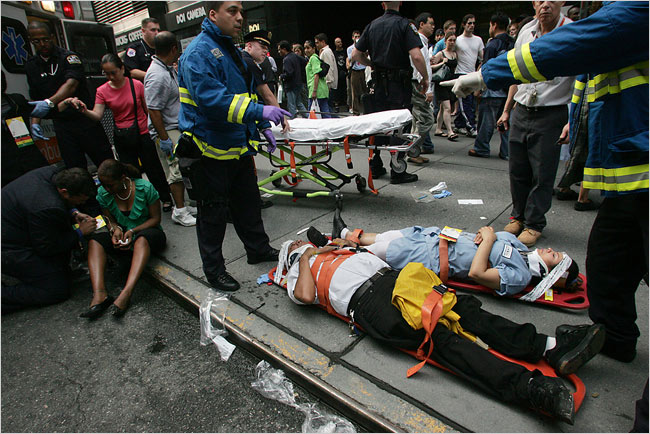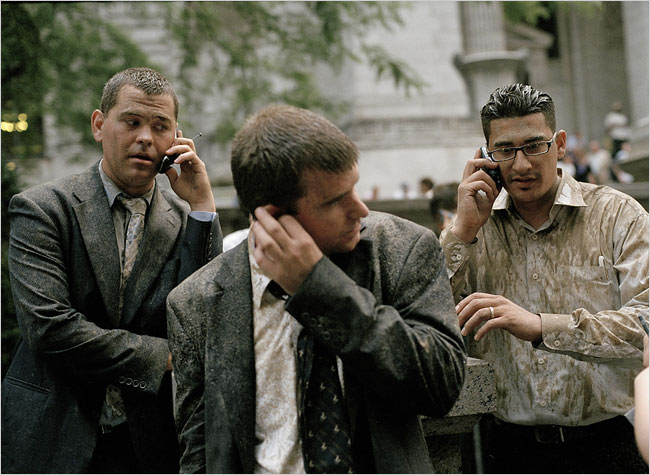The explosion sent up a foul cloud of hot steam mixed with mud, rust-colored gunk and pieces of pavement just before 6 p.m. in one of the busiest parts of the city. The mayor said that some telephone lines had been knocked out, but that electric power had not been.
City officials urged those who might have come into contact with mud or soot from the blast to shower and place their clothes in plastic bags for cleaning or disposal.
Jessica Leighton, a deputy commissioner at the Department of Health and Mental Hygiene, also cautioned people inside buildings near the blast to close windows and set air-conditioners to re-circulate the air inside instead of drawing in air from outside.
As people on the sidewalks scrambled to flee the blast and office workers in the buildings above looked down in horror, debris from the geyser pelted nearby skyscrapers. Then it rained on the streets like a sudden hailstorm. Some witnesses said the jet of steam roared like Niagara Falls.
Some people ran so fast their shoes came off. Others dropped their briefcases and purses. Men in tailored suits were caught in a lapel-singeing cloud. At a health club high up in the Grand Hyatt hotel next to Grand Central, people working out on the treadmills said the explosion was so powerful they worried the building would collapse. The steam shot up from a crater that looked like that of a volcano, with orange flames and bubbling mud around the edges. The explosion packed enough force to flip over a tow truck that ended up in the crater, which was about 35 by 40 feet. Several hours after the blast, officials said the crater could grow even larger because pavement at the edges was in danger of collapse.
The cloud of steam — and the hail of debris that followed — lasted more than two hours and immediately raised concerns about asbestos, which was used when the pipe was laid in the 1920s. Officials advised people who had been in the neighborhood to discard their clothes and bathe carefully.
The mayor said the explosion appeared to have been caused by cold water that reached the pipe, which measured more than a foot and half in diameter and dated to 1924. “Cold water apparently causes these to explode,” he said.
Con Edison, which maintains the steam pipes beneath the city’s streets, said the pipe ruptured at 5:56 p.m. Kevin Burke, the chairman of Con Edison, said crews had checked the pipe after the thunderstorm that soaked the city in the morning. He said a heavy rain can cause a “vapor condition” if rainwater seeps onto a steam pipe, causing the steam to condense. He said the inspection earlier in the day had given no indication that anything was amiss.
There have been more than a dozen steam pipe explosions in the city in the last 20 years. One of the largest shook the neighborhood around Gramercy Park in 1989 and did millions of dollars in damage. Three people were killed, two of them Con Edison employees who had been working in the street before the explosion.
The explosion on Wednesday began with a deep, rumbling noise. “It was, like, surreal, man, this rumbling, like Old Faithful,” said Randy Rocha, a bus driver who was pulling away from a stop on 42nd Street with about 20 passengers aboard when the pipe ruptured.
He described plunging into the suddenly dark street. His uniform was splattered with mud the way a housepainter’s clothes are splattered with color. Mr. Rocha could not read his wristwatch — it too was covered with mud.
In the skyscrapers that surround Grand Central, office workers realized that what they were hearing were not the usual sounds of the evening rush, of buses hitting manhole covers or dump trucks changing gears.
“It sounded at first like thunder, but it just didn’t end,” said Andrew T. Frankel, a lawyer whose office is at Lexington Avenue and 43rd Street.
Tabi Freedman, an information technology specialist who was walking out of Grand Central, said, “The ground was moving, the windows were rattling, and me and everybody else, we all looked up.” She added, “I’ve been to Yellowstone, and that’s what I thought of — the pitch, the volume, the shrieking, the steam and the vibration.”
Ken Houghton, a consultant who works at 101 Park Avenue, between 40th and 41st Streets, said he first thought what was coming down was hail. “Then we saw rocks hitting the window on the seventh floor,” he said. Officials said later that six nearby buildings had sustained minor damage, mainly to windows on the lower floors.
More than 250 firefighters and 300 police officers were sent to the area. The Fire Department treated the blast as if it were a five-alarm blaze, and firefighters who approached the geyser had breathing tanks on their backs. Before long, ambulances were slicing past the stalled cars and buses, and were taking people who had been caught in the shower from the geyser to hospitals.
A trauma worker at Bellevue Hospital Center estimated that a dozen patients suffering minor injuries were taken there. Most of the injuries appeared to have been caused by falling debris; one person sustained a broken ankle, he said. As a precaution, patients were stripped and showered when they arrived.
The one death reported from the explosion was apparently caused by a heart problem. The victim, a woman, had apparently been close to the explosion, he said.
Mr. Burke of Con Edison said a number of 13,000-volt feeder cables for the utility’s electric system had been damaged in the explosion. He said crews would lay new cables under the streets to bypass the damaged ones. He said that 15 to 20 buildings that tap into the steam pipes had been taken out of service.
Five hours after the explosion, wisps of
steam continued to rise from the crater. Lexington Avenue remained closed,
with barricades keeping onlookers two to four blocks away and emergency
vehicles lining the street — ambulances, fire trucks, tractors and fork
lifts. The Lexington Avenue subways were running, but were not stopping at
42nd Street.
